Difference between revisions of "GEANT Moller Simulations Comparison"
(Created page with "https://wiki.iac.isu.edu/index.php/Converting_to_barns https://wiki.iac.isu.edu/index.php/Check_Differential_Cross-Section Converting the number of electrons scattered per angl…") |
|||
| (22 intermediate revisions by the same user not shown) | |||
| Line 1: | Line 1: | ||
| + | <center><math>\textbf{Navigation}</math></center> | ||
| + | |||
| + | <center> | ||
| + | [[Lorentz_Transformation_to_Lab_Frame|<math>\vartriangleleft </math>]] | ||
| + | [[VanWasshenova_Thesis#Weighted_Isotropic_Distribution_in_Lab_Frame|<math>\triangle </math>]] | ||
| + | [[CED_Verification_of_DC_Angle_Theta_and_Wire_Correspondance|<math>\vartriangleright </math>]] | ||
| + | </center> | ||
| + | |||
https://wiki.iac.isu.edu/index.php/Converting_to_barns | https://wiki.iac.isu.edu/index.php/Converting_to_barns | ||
| Line 20: | Line 28: | ||
While this expression has no explicit dependancies on energy, the ratio is a function of the energy, as well as the physical makeup of the target. | While this expression has no explicit dependancies on energy, the ratio is a function of the energy, as well as the physical makeup of the target. | ||
| − | This gives, | + | This gives, |
| − | + | For 5 cm length of a LH2 target: | |
| + | <center><math>\rho_{target}\times l_{target}=\frac{70.85 kg}{1 m^3}\times \frac{1 mole}{2.02 g} \times \frac{1000g}{1 kg} \times \frac{6\times10^{23} molecule}{1 mole} \times \frac{2\ atoms}{molecule}\times \frac{1m^3}{(100 cm)^3} \times \frac{5 cm}{ } \times \frac{1 \times 10^{-24} cm^{2}}{barn} =.21 barns^{-1}</math></center> | ||
| + | |||
| + | ---- | ||
| + | |||
| + | For 1 cm length of a LH2 target: | ||
| + | |||
| + | <center><math>\rho_{target}\times l_{target}=\frac{70.85 kg}{1 m^3}\times \frac{1 mole}{2.02 g} \times \frac{1000g}{1 kg} \times \frac{6\times10^{23} molecule}{1 mole} \times \frac{2\ atoms}{molecule}\times \frac{1m^3}{(100 cm)^3} \times \frac{1 cm}{ } \times \frac{1 \times 10^{-24} cm^{2}}{barn} =.042 barns^{-1}</math></center> | ||
From earlier simulations for random angle Phi, we know that the full range of Theta is limited depending on the target material. | From earlier simulations for random angle Phi, we know that the full range of Theta is limited depending on the target material. | ||
| − | <center>[[File:MollerThetaLab_4e7_LH2_11GeV.png]][[File: | + | <center>[[File:MollerThetaLab_4e7_LH2_11GeV.png]][[File:MollerThetaLab_4e7_LH2_11GeV_Detector.png]]</center> |
| − | <center>[[File: | + | <center>[[File:MolThetaLab4e8LH211GeV.png]][[File:MolThetaLab4e8LH211GeVDetector.png]]</center> |
| + | <center>[[File:4e7_5cm_LH2_MolThetaLab.png]][[File:4e7_5cm_LH2_MolThetaLab_Detector.png]]</center> | ||
| + | |||
| + | ---- | ||
| + | |||
| + | For 4e7 incident electrons: | ||
<center><math>\sigma = \frac{N_{events}}{N_{incident}\ \rho\ \ell}=\frac{975593}{40000000\ \cdot 4.2\times 10^{-2} barns^{-1}}=\frac{0.024}{4.2\times 10^{-2} barns^{-1}}=0.58 barns</math></center> | <center><math>\sigma = \frac{N_{events}}{N_{incident}\ \rho\ \ell}=\frac{975593}{40000000\ \cdot 4.2\times 10^{-2} barns^{-1}}=\frac{0.024}{4.2\times 10^{-2} barns^{-1}}=0.58 barns</math></center> | ||
| Line 48: | Line 68: | ||
<center><math>\mathcal{L} \cdot t_{simulated}=\frac{N_{events}}{\sigma}</math></center> | <center><math>\mathcal{L} \cdot t_{simulated}=\frac{N_{events}}{\sigma}</math></center> | ||
| − | |||
For a Luminosity of <math>\mathcal{L}=\frac{1.3\times 10^{11}}{barn\cdot s}</math> | For a Luminosity of <math>\mathcal{L}=\frac{1.3\times 10^{11}}{barn\cdot s}</math> | ||
| Line 59: | Line 78: | ||
<center><math>t=1.3\times 10^{-5}\ s</math></center> | <center><math>t=1.3\times 10^{-5}\ s</math></center> | ||
| + | |||
| + | ---- | ||
| + | |||
| + | For 4e8 incident electrons: | ||
| + | <center><math>\sigma = \frac{N_{events}}{N_{incident}\ \rho\ \ell}=\frac{9757288}{400000000\ \cdot 4.2\times 10^{-2} barns^{-1}}=\frac{0.024}{4.2\times 10^{-2} barns^{-1}}=0.58 barns</math></center> | ||
| + | |||
| + | |||
| + | |||
| + | <center><math>\sigma=\frac{R_{events}}{\mathcal{L}} \Rightarrow \mathcal{L}=\frac{R_{events}}{\sigma}</math></center> | ||
| + | |||
| + | |||
| + | |||
| + | <center><math>\mathcal{L}=\frac{dN_{events}}{dt}\frac{1}{ \sigma}\Rightarrow \int_{0}^{t_{simulated}}\mathcal {L}\, dt= \int_{0}^{N_{events}}\frac{1}{\sigma}\, dN</math></center> | ||
| + | |||
| + | |||
| + | |||
| + | <center><math>\mathcal{L} \cdot t_{simulated}=\frac{N_{events}}{\sigma}</math></center> | ||
| + | |||
| + | For a Luminosity of <math>\mathcal{L}=\frac{1.3\times 10^{11}}{barn\cdot s}</math> | ||
| + | |||
| + | |||
| + | |||
| + | <center><math>\frac{1.3\times 10^{11}}{barn\cdot s} \cdot t_{simulated}=\frac{9757288}{.58\ barn}</math></center> | ||
| + | |||
| + | |||
| + | |||
| + | <center><math>t=1.3\times 10^{-4}\ s</math></center> | ||
| + | |||
| + | ---- | ||
| + | |||
| + | For 6e7 incident electrons with a 5cm long LH2 target: | ||
| + | <center><math>\sigma = \frac{N_{events}}{N_{incident}\ \rho\ \ell}=\frac{4584834}{60000000\ \cdot .21barns^{-1}}=\frac{0.076}{.21 barns^{-1}}=.361 barns</math></center> | ||
| + | |||
| + | |||
| + | |||
| + | <center><math>\sigma=\frac{R_{events}}{\mathcal{L}} \Rightarrow \mathcal{L}=\frac{R_{events}}{\sigma}</math></center> | ||
| + | |||
| + | |||
| + | |||
| + | <center><math>\mathcal{L}=\frac{dN_{events}}{dt}\frac{1}{ \sigma}\Rightarrow \int_{0}^{t_{simulated}}\mathcal {L}\, dt= \int_{0}^{N_{events}}\frac{1}{\sigma}\, dN</math></center> | ||
| + | |||
| + | |||
| + | |||
| + | <center><math>\mathcal{L} \cdot t_{simulated}=\frac{N_{events}}{\sigma}</math></center> | ||
| + | |||
| + | For a Luminosity of <math>\mathcal{L}=\frac{1.32\times 10^{11}}{barn\cdot s}</math> | ||
| + | |||
| + | |||
| + | |||
| + | <center><math>\frac{1.32\times 10^{11}}{barn\cdot s} \cdot t_{simulated}=\frac{4584834}{.361\ barn}</math></center> | ||
| + | |||
| + | |||
| + | |||
| + | <center><math>t=9.62\times 10^{-5}\ s</math></center> | ||
| + | |||
| + | |||
| + | ---- | ||
| + | |||
| + | For 6e6 incident electrons with a 5cm long LH2 target: | ||
| + | <center><math>\sigma = \frac{N_{events}}{N_{incident}\ \rho\ \ell}=\frac{732603}{6000000\ \cdot .21barns^{-1}}=\frac{0.122}{.21 barns^{-1}}=.58 barns</math></center> | ||
| + | |||
| + | |||
| + | |||
| + | <center><math>\sigma=\frac{R_{events}}{\mathcal{L}} \Rightarrow \mathcal{L}=\frac{R_{events}}{\sigma}</math></center> | ||
| + | |||
| + | |||
| + | |||
| + | <center><math>\mathcal{L}=\frac{dN_{events}}{dt}\frac{1}{ \sigma}\Rightarrow \int_{0}^{t_{simulated}}\mathcal {L}\, dt= \int_{0}^{N_{events}}\frac{1}{\sigma}\, dN</math></center> | ||
| + | |||
| + | |||
| + | |||
| + | <center><math>\mathcal{L} \cdot t_{simulated}=\frac{N_{events}}{\sigma}</math></center> | ||
| + | |||
| + | For a Luminosity of <math>\mathcal{L}=\frac{1.32\times 10^{11}}{barn\cdot s}</math> | ||
| − | |||
| + | <center><math>\frac{1.32\times 10^{11}}{barn\cdot s} \cdot t_{simulated}=\frac{732603}{.58\ barn}</math></center> | ||
| − | |||
| − | |||
| − | |||
| − | |||
| − | |||
| − | |||
| − | |||
| − | |||
| − | |||
| − | |||
| − | |||
| − | |||
| − | |||
| − | |||
| − | |||
| − | |||
| − | |||
| − | |||
| − | |||
| − | + | <center><math>t=9.57\times 10^{-6}\ s</math></center> | |
Latest revision as of 14:22, 29 March 2018
https://wiki.iac.isu.edu/index.php/Converting_to_barns
https://wiki.iac.isu.edu/index.php/Check_Differential_Cross-Section
Converting the number of electrons scattered per angle theta to barns, we can use the relation
If the time is taken to be the same for the amount scattered as for the amount incident (the time simulated), this can be viewed as the probability of one incident electron producing a Moller event.
While this expression has no explicit dependancies on energy, the ratio is a function of the energy, as well as the physical makeup of the target.
This gives,
For 5 cm length of a LH2 target:
For 1 cm length of a LH2 target:
From earlier simulations for random angle Phi, we know that the full range of Theta is limited depending on the target material.
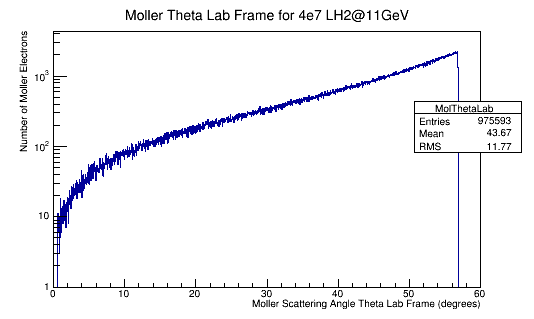
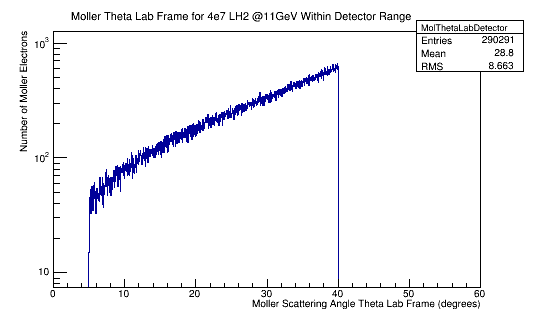
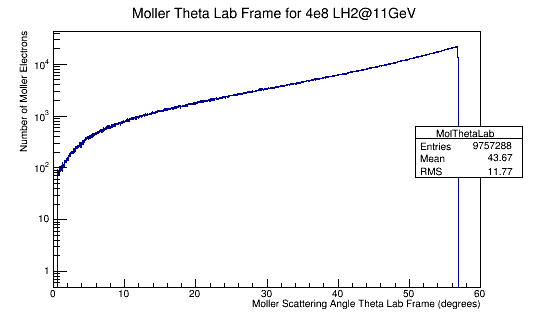
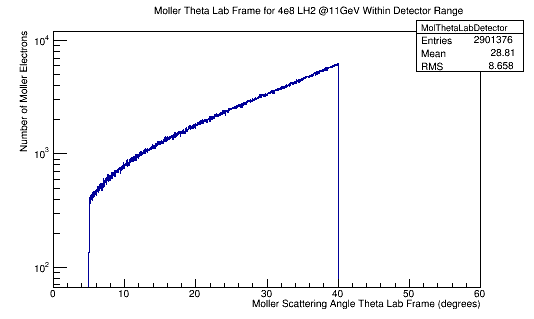
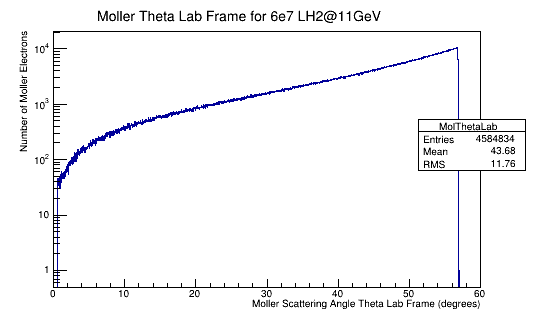
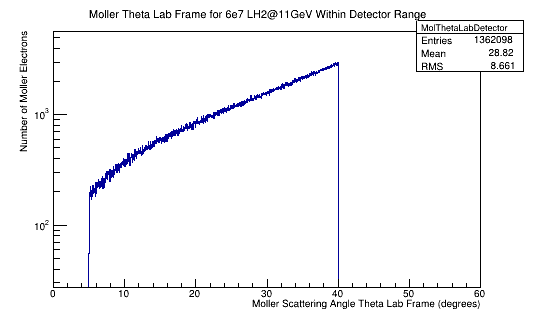
For 4e7 incident electrons:
For a Luminosity of
For 4e8 incident electrons:
For a Luminosity of
For 6e7 incident electrons with a 5cm long LH2 target:
For a Luminosity of
For 6e6 incident electrons with a 5cm long LH2 target:
For a Luminosity of